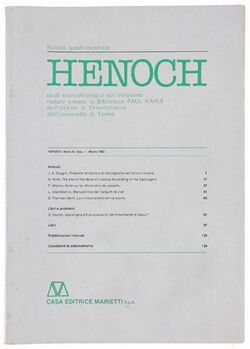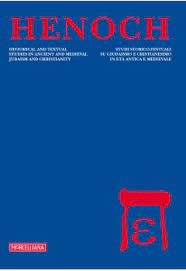Henoch (1979-2004 Zamorani / 2005- Morcelliana), journal
Henoch: Studies on Judaism and Christianity from the Second Temple to Late Antiquity is an academic journal, founded in 1979 by Paolo Sacchi. Published by Zamorani (Turin: 1979-2004) and then Morcelliana (Brescia: 2005-). Currently, the journal is edited by Corrado Martone.
History
The Journal HENOCH was founded in 1979 by Paolo Sacchi, Professor of Hebrew and Aramaic at the University of Turin, Italy. HENOCH: Studi storicofilologici sull’ebraismo [Historical and Philological Studies on Judaism] was born the same year the Associazione Italiana per lo Studio del Giudaismo (AISG) was also created. The interests of the Journal ranged from the Bible to contemporary Judaic studies, but already with a clear emphasis on ancient Judaism, including Christian Origins.
For the first eight years (I / 1979 – VIII /1986) the journal was published by Marietti (Casale Monferrato, then Genoa, Italy). Members of the Board of Directors were Giovanni Garbini (University of Pisa, then Rome), Luigi Moraldi (University of Pavia), Paolo Sacchi (University of Turin), Jan Alberto Soggin (University of Rome), and Giuliano Tamani (University of Venice). During those pioneering years the journal was composed, literally typewritten, at the University of Turin. Bruno Chiesa was then primarily in charge for the composition of the journal, with the collaboration of Liliana Rosso Ubigli (1982-87), Aldo Moda (1979-1984), Pier Giorgio Borbone (1980-1984), Maurizio Miele (1980-1982), and Giuseppe Slaviero (1984-1987). Henoch was an Italian Journal with more than half of its articles published in Italian, but since the beginning hosted a large percentage of contributions in Spanish, English, French and German (abstracts were published in French).
In 1987 the Publisher Zamorani (Turin, Italy) took the responsibility of the journal and in 1989 (until XVII / 1995) Bruno Chiesa became the new Editor-in-Chief. A new stage in the life of the Journal began. The Board of Directors gradually expanded over the years to include: Bruno Chiesa (University of Pavia), Giovanni Garbini (University of Rome, until 1988), Luigi Moraldi (University of Pavia, until 1991), Paolo Sacchi (University of Turin), Jan Alberto Soggin (University of Roma), Giulio Tamani (University of Venice), Angelo Vivian (Martin Buber Institut für Judaistik Köln, until hid death in 1991), Giulio Busi (University of Venice, from 1992), Luigi Cagni (Oriental Intitut Naples, from 1992), Claudio Gianotto (University of Perugia, from 1992), Alexander Rofé (Hebrew University of Jerusalem, from 1992). Pier Giorgio Borbone was now primarily in charge for the composition of the Journal with the collaboration of Liliana Rosso Ubigli (1987-1991), Gabriele Boccaccini (1987-1989), Giuseppe Slaviero (1987), and then, (since 1992) of Piero Capelli, Corrado Martone and Mauro Zonta. Most articles were published in Italian, with contributions in English, German, French and Spanish. But things were rapidly changing. In 1992, the journal became bilingual (Italian/English) with English abstracts.
In XVIII / 1996 (until XXVI / 2004) Claudio Gianotto succeeded Bruno Chiesa as the new Editor-in-Chief. The Board of Directors was limited to Paolo Sacchi, Bruno Chiesa, Claudio Gianotto, and (since 1999) Florentino García Martínez. A new large, international Advisory Board was created: Haggai Ben-Shammai (Hebrew University of Jerusalem), Gabriele Boccaccini (University of Michigan), Giulio Busi (University of Venice, then Freie Universität Berlin), Luigi Cagni (Oriental Institute Naples, until his death in 1998), Alexander A. Di Lella (Catholic University of America, from 2000), Enrico Norelli (University of Geneva), Michele Piccirillo (Studium Biblicum Franciscanum), Alexander Rofé (Hebrew University of Jerusalem), Jan Alberto Soggin (University of Rome), Günter Stemberger (University of Wien), and Giulio Tamani (University of Venice). Corrado Martone was now primarily in charge for the composition of the journal, with the collaboration of Piero Capelli, Pier Giorgio Borbone (1996-1998), Maria Teresa Milano (1998-2002), Maria Sita Demichelis (1998-2000), Gaia Lembi (2001-2004), Silvia Ceriani (2001-2004), Ilaria Bertone (2004), and Chiara Pilocane (2004). The majority of articles were now published in Italian or English, and less frequently in German, French or Spanish.
In 2005, a new series was launched. The Journal was taken by a new Publisher, Morcelliana (Brescia, Italy), and Gabriele Boccaccini became the new Editor-in-Chief. As signified by the new subtitle: Studies in Judaism and Christianity from Second Temple to Late Antiquity, the Journal shifted its focus from the broader field of Judaic Studies to the period following the Babylonian exile up to the rise of Islam. The journal took advantage of the renewed interesting in Judaism and Christianity of Late Antiquity as well as of the international success of the Enoch Seminar in the field of Second Temple Judaism and Christian Origins. The new Board of Directors included professors from the University of Turin and the University of Michigan: Paolo Sacchi, Gabriele Boccaccini, Yaron Eliav (2005-08), Claudio Gianotto, and Corrado Martone. Giovanni Ibba is now primarily in charge for the composition of the journal with the collaboration of the other members of the Publishing Commission. English has become the main language of the Journal and of the majority of its articles, but contributions are published also in French, German, or Italian.
In 2012 Corrado Martone succeeded Gabriele Boccaccini as the new Editor-in-Chief of the Journal.

